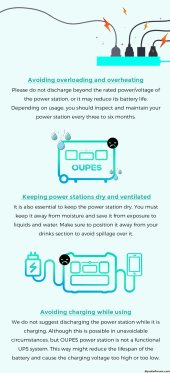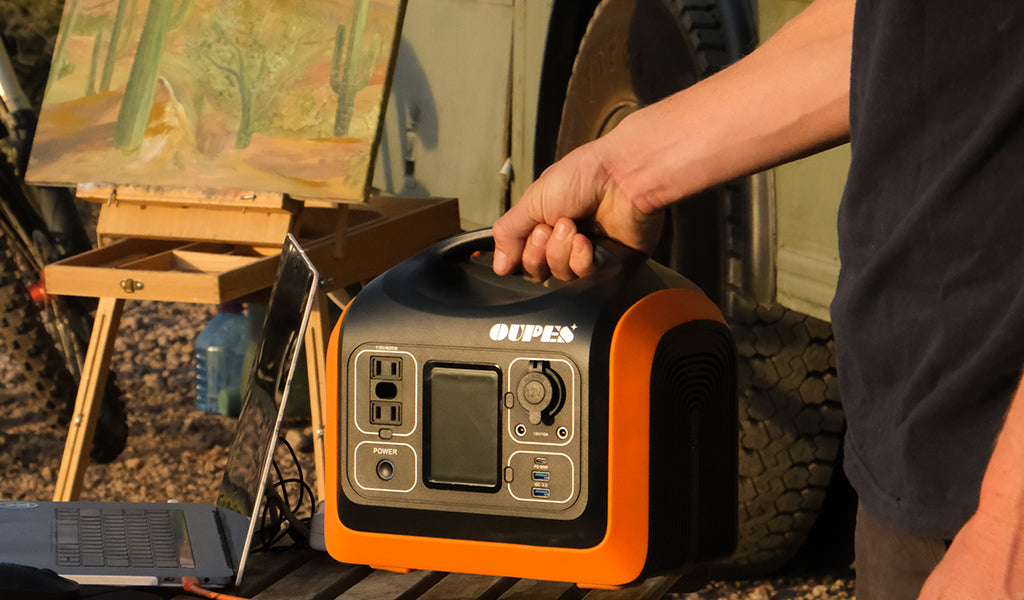A friend of mine purchased two Oupes Solar Generators, one 2400 and one 1200.
They emailed them stating:
Now this flies in the face of everything I know about electricity.
Have they done a terrible job of designing their product, that charging while discharging could cause a battery over-voltage situation?!? Can anyone explain why they say this? Why would a manufacturer state this, or design a solar generator that would damage the system if you had input power to the system, as well as a load attached? Would the input power not get redirected to the load first, then charge the battery if the input power was greater than the load? Or if the load was greater than the input power, take 100% of the input power plus some of the battery toward the load?
This seems highly suspicious.
I have attached the image from the email.
So I am new to the whole solar thing and purchased an OUPES MEga 3 to start my journey. I am wondering if they have that warning to just protect themselves from any claims. In their Blog section on their website they basically say it's ok to charge and discharge:
Can A Solar Generator Be Used While Recharging?
Of course, many people will doubt: Can I use a solar generator portable while it is charging? For other products, this is not a sure thing. However, if you use the solar generator of OUPES, you will find: the answer is yes! When you connect your solar generator to an outlet or power source, it will automatically start charging from that source. But what happens if you need to use your solar generator during this process? For example, maybe you want to watch TV or listen to music on your portable radio while your solar generator is plugged in and charging up its battery pack.
In most cases, this isn’t a problem at all because all modern-day generators are smart devices with their own dedicated battery packs that recognize when they are being charged and automatically shut off when they reach full capacity (this is known as “float mode”). Therefore, you can use your solar generator while it is charging without any issues. In fact, it might even be useful to do so because this will allow you to power your devices right away instead of waiting for hours until the generator is fully charged.
In fact, if a generator can't be used by people to charge their own computers while it's charging itself, it's very not cost-effective. You can think about it, it takes a few hours for a generator to fully charge, and then you need to use it for a few hours and then wait for a few hours again. This seems like a bit of a loss, doesn't it? Because its gap period is very long. Still, if you're not in a hurry to use electricity, it's not really that big of a deal. So, it would be very convenient if it could power your device while charging itself.
What To Expect When You Use A Solar Generator While It’s Charging?
You can use a solar generator while it is charging. The question is, what will happen if you do? The short answer is that the generator will not damage itself by using it while charging. It will not hurt the battery, and it won’t affect its lifespan.
The reason that using a generator while charging is okay is that the power draw needed to run most appliances is not great enough to affect the charging process. The only thing that could potentially cause an issue would be if you were to run an appliance with a high power draw (like an air conditioner), but even then, this would only cause a slight delay in your charging time. So what happens when you use your generator while it's recharging? Here are some things to expect:
A slight delay in charging time:
There will be a slight delay in how long it takes for your generator to reach full charge. This is because it takes some time for the solar panels to produce enough electricity to match what you're using from them. A slight delay in charging time (usually no more than 30 minutes). This delay can be longer if there is any cloud cover or if you have a lot of appliances running at once (like many people do when cooking or eating).
A mild decrease in battery life expectancy:
There will be a mild decrease in battery life expectancy – but this decrease will be minimal and won’t make much difference after just one use. As long as you don't overdo it and only use it for short periods of time, you should have no problem getting quite a few uses out of it before needing another charge.
However, You Need It:
However, you can switch your thinking. A solar generator portable is a great option for powering up in an emergency, so you'll need it. But "emergency", as it literally means, doesn't happen very often. So even though you're using the solar generator portable to charge your own device while it's charging yourself, it will do a little bit of damage. However, as long as you compare it, you will find that this little damage brings a lot of conveniences - at least your work can be completed in an emergency power outage.
Second, if a solar generator portable is a must for you, for example, if you are a perennial camper. Rather than be bothered that it reduces performance, you might as well find a solar generator portable that is more powerful and has a short recharge time. It is recommended that you choose OUPES.
Conclusion:
To sum up, you don't have to worry about using a portable solar generator while charging. It will neither pose a threat to your security, nor will it have a great impact on its own performance. Maybe it will have some subtle effects, but compared to the convenience it brings, it's really not worth mentioning. It is worth mentioning that you can find power stations with premium performance. Such as shorter charging time, longer battery life and so on. Their "innate" qualities will make them serve you better and longer!




